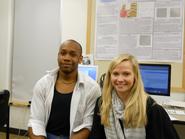
As much as science has uncovered about the human brain, the relationship between brain and movement remains relatively unclear. For example, when attempting to point to or touch a specific, moving target, response times vary based on a wide variety of factors. While certain laws and formulas attempt to form a connection between movement and variables such as target size and distance, there is still much work to be done about how the brain interprets and carries out movement.
Over the summer, Elin Lantz ’13 and Robert Hawkins ’13 will work with Professor of Psychology and Neuroscience Jonathan Vaughan on a study of how speed and accuracy of movement are different in the right and left hands.
They will build off Professor Vaughan’s previous studies regarding movement from past summers. Specifically, Lantz and Hawkins will draw from Fitts’s Law, which relates the size and distance of a given “target area” to the speed with which a person can move to that target. Simply put, Lantz describes Fitts’s law as “a mathematical measurement of how easy certain movements are.” For their study, Lantz and Hawkins will compare speed of movement toward a target between the right and left hand. In other words, they will compare “ease of movement” between two hands.
Study participants were asked to rapidly tap a set of targets with a pointer, while an instrument called a Nest of Birds picked up where and when a movement is made. The researchers can then translate the Nest of Birds’ recordings to MATLAB computer software, creating readable data.
The team ultimately hopes to find support for the Liepmann Model, which states that the left hemisphere of the brain controls action-initiation, and so it takes time for the action to carry over to the right hemisphere. Because the right hemisphere controls the left hand and the left hemisphere controls the right, Liepmann’s Model translates into faster movements in the right hand. This is because the action is carried out from the same hemisphere that it originates in. The group will focus their study on right-handed people, though they are also compiling a smaller data set on left-handed people that may be used later.
Hawkins, Lantz and Vaughan have already finished running participants for their first experiment and are now performing data analysis on their findings. After this step is completed, they will evaluate their findings in order to design the next step of the study. They plan to focus on a particularly interesting or unexpected aspect of the current experiment to create future experiments. To inform their research further, Lantz and Hawkins will also study published literature on the subject.
According to Lantz, a psychology major with a history minor, motor planning is a mysterious aspect of neuroscience, and the opportunity to explore it further is both interesting and exciting. She enjoys the process of planning and executing experiments. On the other hand, Hawkins, a neuroscience major, most looks forward to observing data, or the final results of the experiments. Both students also anticipate the prospect of becoming better acquainted with MATLAB, which is useful in much of psychology research.
In his free time, Hawkins enjoys archery and fencing. He also has a passion for writing and plans to take on a creative writing minor. Lantz’s other interests include history, which she explores in her minor. She plays the violin in the college orchestra, takes violin lessons, and has participated in various theater productions at Hamilton.
The two students look forward to their summer research and find it not only immediately interesting, but highly applicable to their future in psychology or neuroscience.
Hawkins is a graduate of the Charter School of Wilmington, Del. Lantz is a graduate of Benilde-St. Margaret’s School in Minnesota.
